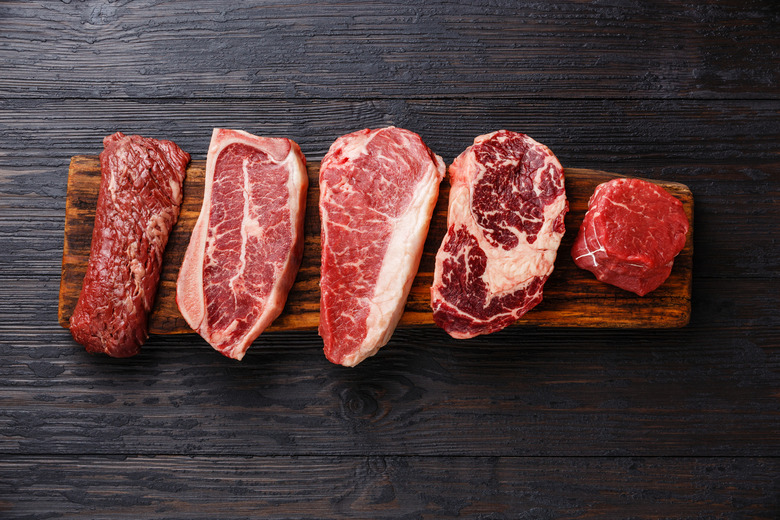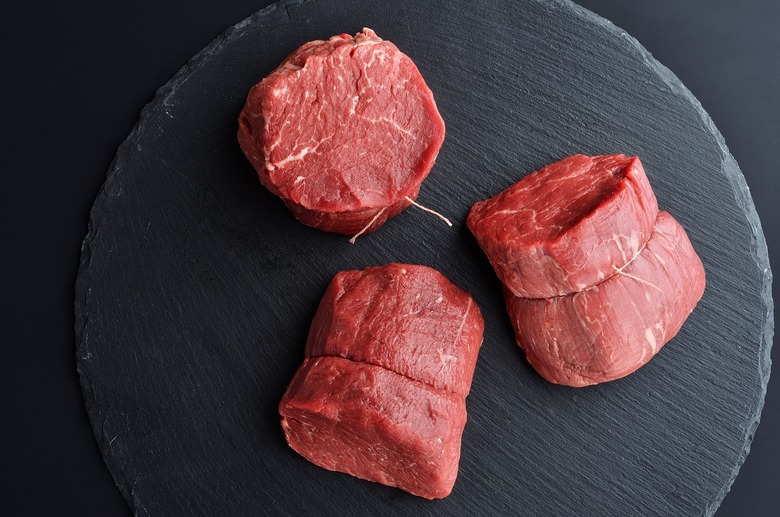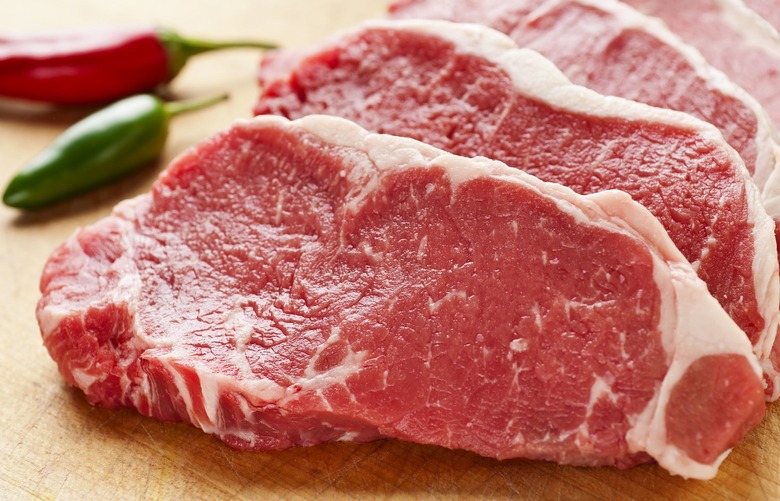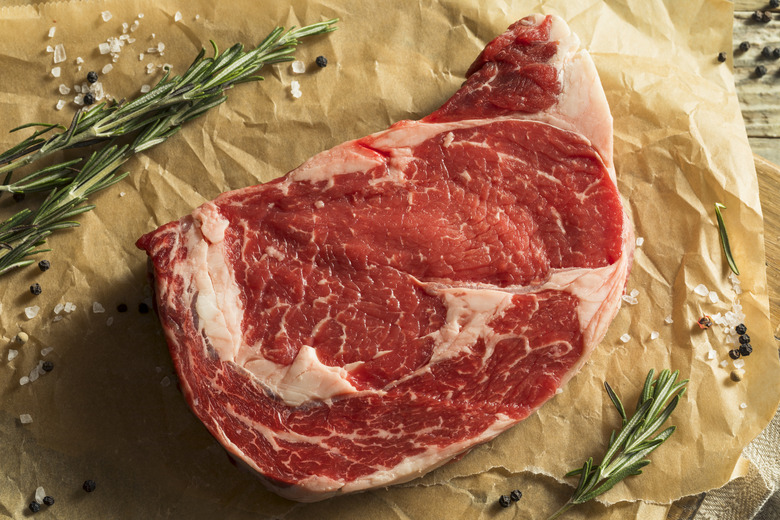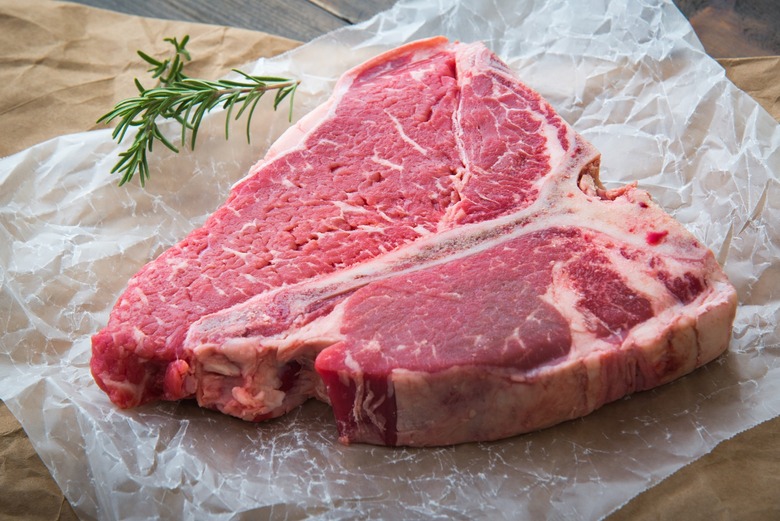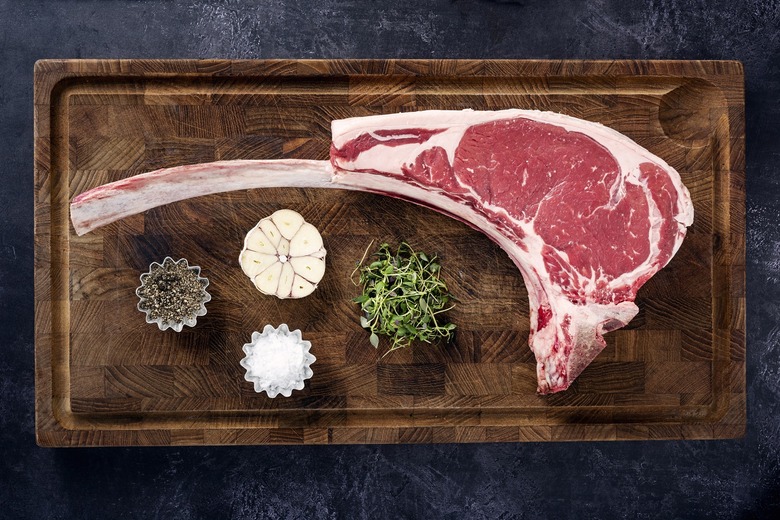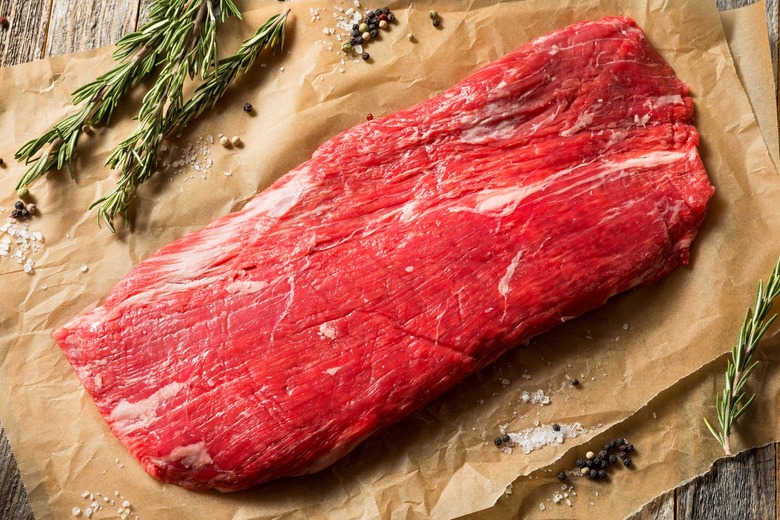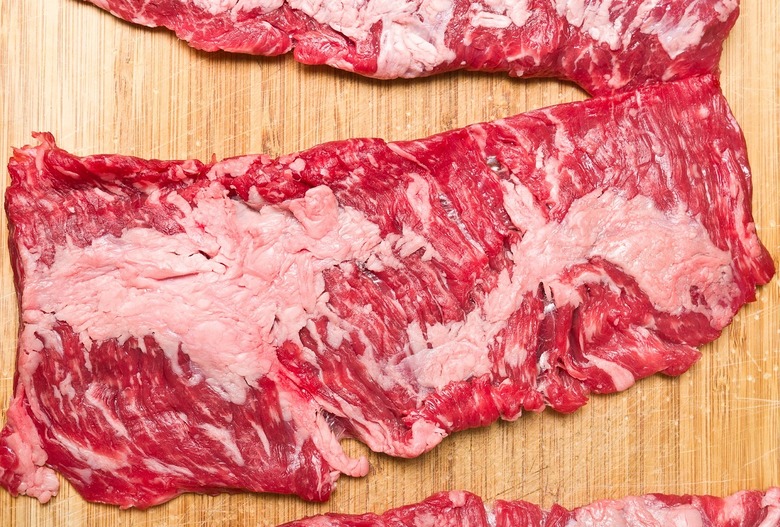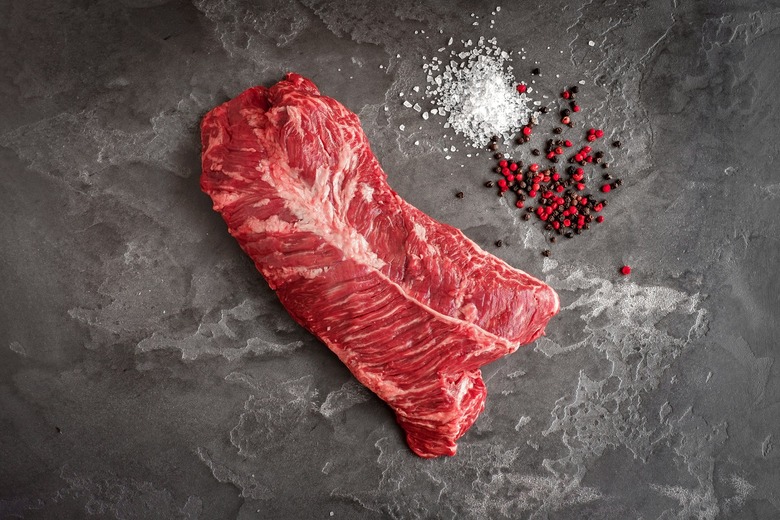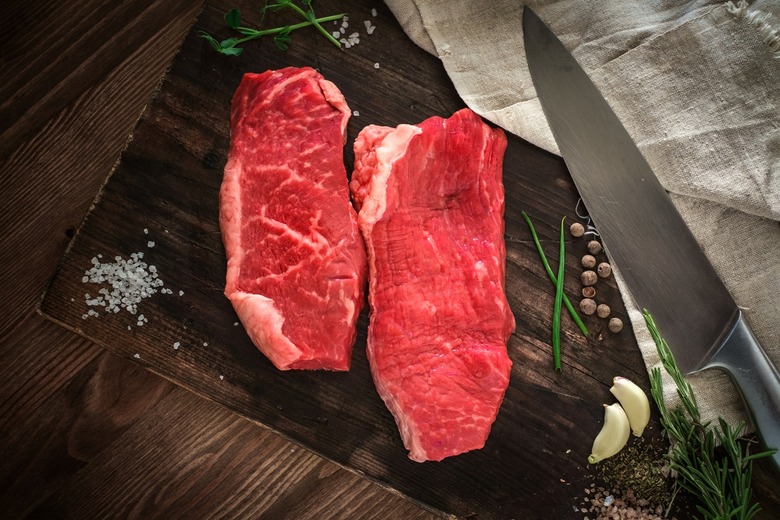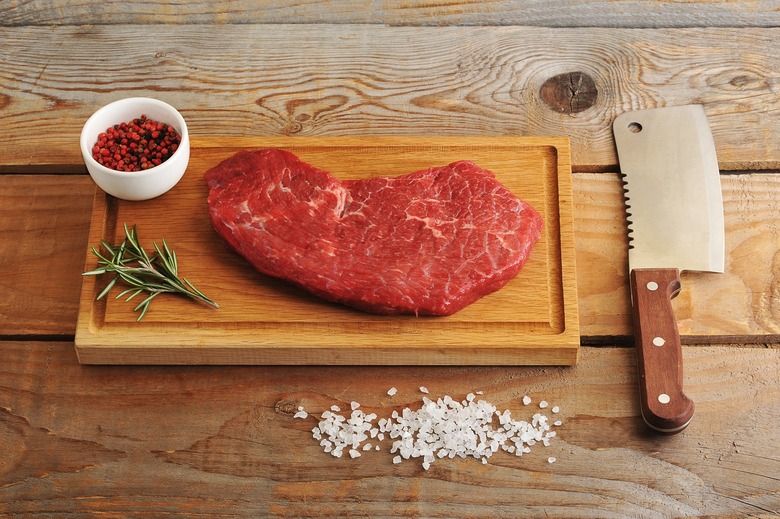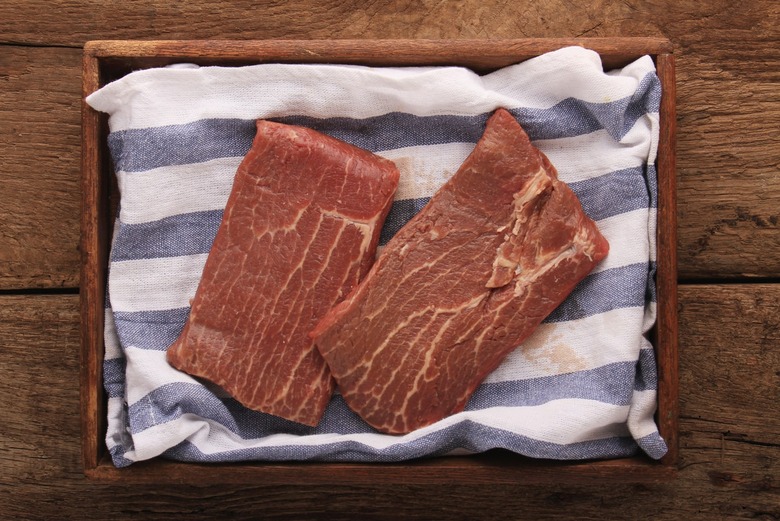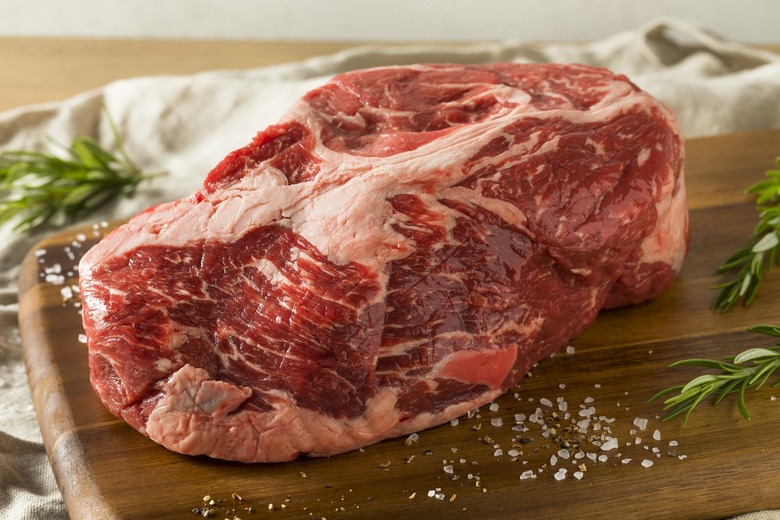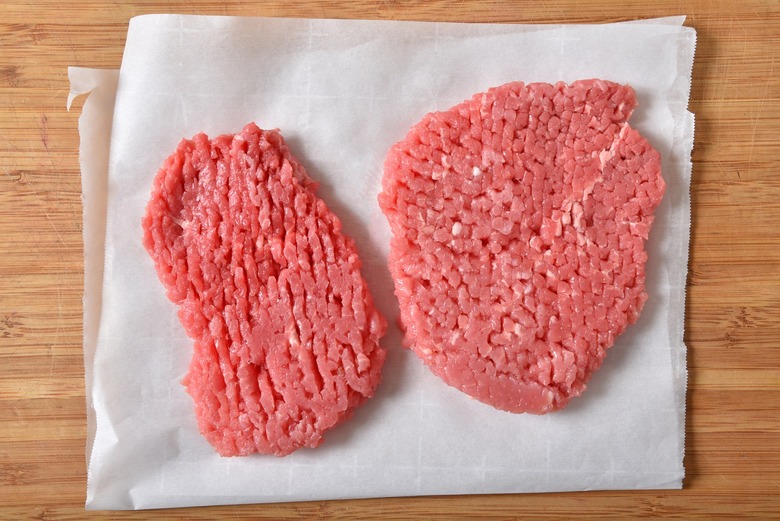Every Cut Of Steak You Need To Know
For many of us, there's nothing better than a perfectly-cooked steak. But if your entire range of steak knowledge starts at filet mignon and ends at T-bone, then we've got some news for you: there are lots of different cuts of steaks out there, and they all have their merits. Let's break down every cut of steak you need to know.
Filet Mignon
The filet mignon is cut from the tenderloin. Because it's a muscle that doesn't get much use, it's incredibly tender and when cooked correctly can be cut with a fork. That makes it quite expensive. It's super easy to cook, but it can lack in the flavor department because it's so lean, so it helps when it's wrapped in bacon. Also be sure not to overcook a filet, or they'll be extremely dry.
New York Strip
A steakhouse favorite, the New York strip — also called a strip steak — is cut from the short loin, which is located about three-quarters of the way back on the cow. It tends to be boneless and well-marbled. The muscle (called the longissimus) is quite long, so it's possible to cut into substantial portions. It's a versatile and tender steak, and is best grilled or seared in a hot pan. It's excellent in this grilled steak and potato salad.
Ribeye
Ribeye steaks are cut from the center of the rib section, and can be served either boneless or bone-in. Most of the fat and outer muscles are removed, leaving a lean "eye" and a well-marbled outer cap. It's one of the most desirable pieces of meat on the entire steer because it's fatty, full of flavor and can be forgiving when cooked. It will stay juicy even when overcooked, so it's a great cut for rookie grillers. There's no need to marinade ribeye; it's great seasoned with sea salt, pepper and garlic powder so the beefy flavor can shine through. But if you want to get creative, coat your ribeyes in a rub made from tea leaves, salt and sugar before grilling.
Porterhouse
The porterhouse is another steakhouse favorite, and is actually made up of two individual cuts: the strip and the tenderloin (filet), separated by a t-shaped bone. Porterhouses tend to be thick-cut, and cut from farther back on the cow to include more of the tenderloin than its close relative, the T-bone. This is a great steak for couples, who can split this massive piece of meat with ease.
Tomahawk
If you like the flavor of a ribeye but want something with an insane presentation, opt for the tomahawk steak. This showy piece of beef, which you'll see at some of the best steakhouses in America, is taken from the loin of the steer. This cut usually top two pounds and is distinctive by its thickness, marbling and sizable Frenched bone, which is left on the steak when butchering.
Flank Steak
The flank is essentially the abdominal muscles of the cow. It's quite lean because of the amount of work it gets, and is best marinated and cooked quickly over high heat to medium rare. Grilled flank steak is excellent, and flank is also a popular choice for fajitas. In order to avoid toughness, it needs to be sliced against the grain.
Skirt Steak
The skirt is actually the cow's diaphragm, and is one of, if not the most flavorful cuts on the cow, although it's not especially tender because it has a lot of conenctive tissue. This means it takes very well to acidic marinades, and is best when quickly grilled over high heat and sliced against the grain. It's most common use is for fajitas, though we also love it in this lettuce wraps recipe.
Hanger Steak
The hanger steak is cut from the plate section of the cow, over the belly. It gets its name because it hangs from the diaphragm, between the ribs and the loin; it isn't connected to any bones. Like skirt and flank steaks, this is a tender, flavorful cut but benefits from marinades that break down the fibers. It is best when served rare or medium rare to avoid becoming tough.
Sirloin
Also known as top sirloin, sirloin comes from the back of the cow, adjacent to the tenderloin, and can be cut into several different steaks: the bottom sirloin (usually called the rump), and the top sirloin, which is more tender and lean. This is an affordable cut of steak and cooks up quickly, making it ideal for easy weeknight dinners. It's wonderful with a Cuban-inspired marinade and grilled and can even be cooked in the Instant Pot.
London Broil
The term London broil actually refers to the finished dish rather than a specific cut, but you'll still find steaks at the store by this name. That London broil is usually the top round, a very lean cut above the rear legs of the cow. London broil needs to be cooked quickly at high heat to rare or medium rare, or else it will become very tough. Or, try marinatining the steak in a cherry BBQ sauce or in yogurt to tenderize this steak before grilling.
Flatiron Steak
Flatiron steak comes from the shoulder (chuck), directly under the shoulder blade. It's well marbled and tends to be juicy and flavorful. However, it has a gristly membrane running directly through the center of it, which makes it undesirable to some. Steaks cross-cut through the flatiron steak are called blade steaks. If you have an immersion circulator, sous vide flatiron steaks turn out fantastically.
Chuck Steak
The chuck is essentially the steer's shoulder, and is therefore full of connective tissue, making it best for braising, slow cooking or turning into pot roast. It's still a fairly popular steak choice due to its low price and rich flavor, however, and can take well to quick, hot cooking. Because there are so many individual muscles in the chuck, new steaks are being derived from it all the time; a recent invention is the Denver cut.
Minute/Cube Steak
Minute steak, also called cube steak, is cut from the top round. It is sliced thinly and usually tenderized. It's the most popular cut for chicken fried steak, and is called "minute steak" because it cooks up in just 1 minute.
Prime Rib
Prime rib, also known as standing rib roast, is technically a roast instead of a steak, and is cut from the rib section of the cow. It can comprise anywhere between two and seven ribs, and is roasted whole. As the name might imply, this is the same section of the cow that ribeyes come from. Before you invest in this pricey roast, learn how to buy and cook the perfect prime rib.
More from The Daily Meal:
The Best Ways to Cook Cheap Steaks
10 Beef Recipes Beyond Sloppy Joes and Bolognese
Steakhouse Secrets Only the Experts Know
How to Cook Chicken, Turkey, Steak and 12 Other Foods Correctly
